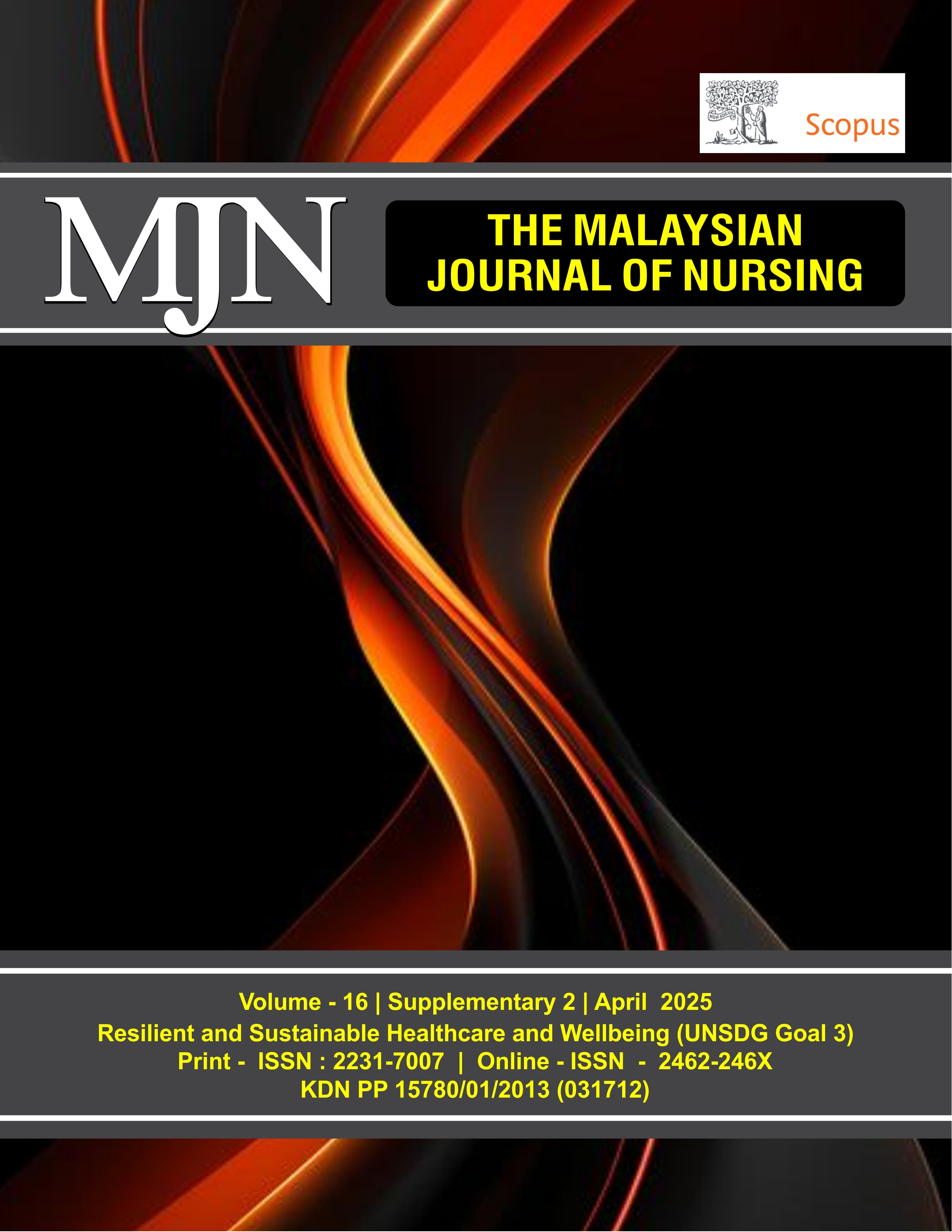Effectiveness of Digital-Based Continuity of Midwifery Care on Client Satisfaction in West Java, Indonesia
DOI:
https://doi.org/10.31674/mjn.2025.v16isupp2.005Abstract
Background: Continuity of midwifery care ensures consistent, personalised support across the maternity cycle and is linked to better maternal and neonatal outcomes. In low-resource areas like West Java, implementation is challenged by geographic and workforce limitations. Digital-based continuity of care has emerged as a promising approach to overcome geographical and logistical barriers, particularly in low-resource settings such as West Java, Indonesia. Objective: This study evaluated the impact of a digital-based continuity of midwifery care program on postpartum client satisfaction zin West Java, Indonesia. Methods: A quasi-experimental design was employed, involving 300 postpartum women divided equally into intervention (digital-based care) and control (standard care) groups for six weeks. The intervention utilised a digital platform that offered features such as appointment scheduling, health education materials, and real-time communication with midwives. Client satisfaction was measured using the Indonesian version of the Patient Satisfaction Questionnaire Short Form (PSQ-18). Data were analysed using paired t-tests and ANCOVA to adjust for potential confounding variables such as age, education, and parity when comparing satisfaction scores between groups. Results: The intervention group showed significant improvements in satisfaction scores across all PSQ-18 subscales compared to the control group. Adjusted mean differences were statistically significant, with moderate to large effect sizes (Cohen’s d: 0.52–0.70). The digital platform significantly enhanced accessibility, communication, and interpersonal engagement, contributing to higher satisfaction levels among participants. Conclusion: Digital-based continuity of midwifery care effectively improves client satisfaction by improving accessibility, facilitating effective communication, and providing personalised support. Future research should investigate the long-term effectiveness and scalability of digital-based continuity of care interventions.
Keywords:
Client Satisfaction, Continuity of Care, Digital Health, Midwifery, Mobile Health EducationDownloads
References
Akbar, M., & Wijaya, G. (2024, June). Digital literacy of rural areas in Indonesia: Challenges and opportunities. In Proceedings of the 4th International Conference on Rural Socio-Economic Transformation, RUSET 2023, 1st November 2023, Bogor, Indonesia. https://doi.org/10.4108/eai.1-11-2023.2344347
Ameyaw, E. K., Amoah, P. A., & Ezezika, O. (2024). Effectiveness of mHealth apps for maternal health care delivery: Systematic review of systematic reviews. Journal of Medical Internet Research, 26. https://doi.org/10.2196/49510
Faul, F., Erdfelder, E., Buchner, A., & Lang, A. G. (2009). Statistical power analyses using G*Power 3.1: Tests for correlation and regression analyses. Behavior Research Methods, 41(4). https://doi.org/10.3758/BRM.41.4.1149
Gentili, A., Failla, G., Melnyk, A., Puleo, V., Di Tanna, G. L., Ricciardi, W., & Cascini, F. (2022). The cost-effectiveness of digital health interventions: A systematic review of the literature. Frontiers in Public Health, 10. https://doi.org/10.3389/fpubh.2022.787135
Golden, B. N., Elrefaay, S., McLemore, M. R., Alspaugh, A., Baltzell, K., & Franck, L. S. (2024). Midwives’ experience of telehealth and remote care: a systematic mixed methods review. BMJ Open, 14(3). https://doi.org/10.1136/bmjopen-2023-082060
Hadi, A. (2018). Bridging Indonesia’s digital divide: Rural-urban linkages. Jurnal Ilmu Sosial dan Ilmu Politik, 22(1), 17-33. https://doi.org/10.22146/jsp.31835
Jayousi, S., Barchielli, C., Alaimo, M., Caputo, S., Paffetti, M., Zoppi, P., & Mucchi, L. (2024). ICT in Nursing and Patient Healthcare Management: Scoping Review and Case Studies. Sensors, 24(10). https://doi.org/10.3390/s24103129
Jiang, X., Ming, W. K., & You, J. H. (2019). The cost-effectiveness of digital health interventions on the management of cardiovascular diseases: systematic review. Journal of Medical Internet Research, 21(6). https://doi.org/10.2196/13166
Knop, M. R., Nagashima-Hayashi, M., Lin, R., Saing, C. H., Ung, M., Oy, S., ... & Yi, S. (2024). Impact of mHealth interventions on maternal, newborn, and child health from conception to 24 months postpartum in low-and middle-income countries: A systematic review. BMC Medicine, 22(1), 196. https://doi.org/10.1186/s12916-024-03417-9
Lindberg, J., Bhatt, R., & Ferm, A. (2021). Older people and rural eHealth: perceptions of caring relations and their effects on engagement in digital primary health care. Scandinavian Journal of Caring Sciences, 35(4). https://doi.org/10.1111/scs.12953
Marston, C., Renedo, A., & Miles, S. (2021). Community participation is crucial in a pandemic. The Lancet, 395(10238), 1676–1678. https://doi.org/10.1016/S0140-6736(20)31054-0
Ngo, E., Truong, M. B. T., & Nordeng, H. (2020). Use of decision support tools to empower pregnant women: Systematic review. Journal of Medical Internet Research, 22(9). https://doi.org/10.2196/19436
Nittas, V., Daniore, P., Chavez, S. J., & Wray, T. B. (2024). Challenges in implementing cultural adaptations of digital health interventions. Communications Medicine, 4(1). https://doi.org/10.1038/s43856-023-00426-2
O’Shea, A. M., Howren, M. B., Mulligan, K., Haraldsson, B., Shahnazi, A., & Kaboli, P. J. (2023). Quantifying the digital divide: associations of broadband internet with tele-mental health access before and during the COVID-19 pandemic. Journal of General Internal Medicine, 38(Suppl 3), 832-840.
https://doi.org/10.1007/s11606-023-08120-8
Pierce, P., Whitten, M., & Hillman, S. (2023). The impact of digital healthcare on vulnerable pregnant women: A review of the use of the MyCare app in the maternity department at a central London tertiary unit. Frontiers in Digital Health, 5. https://doi.org/10.3389/fdgth.2023.1155708
Ramachandran, M., Brinton, C., Wiljer, D., Upshur, R., & Gray, C. S. (2023). The impact of eHealth on relationships and trust in primary care: A review of reviews. BMC Primary care, 24(1). https://doi.org/10.1186/s12875-023-02176-5
Ridgway, J. P., Uvin, A., Schmitt, J., Oliwa, T., Almirol, E., Devlin, S., & Schneider, J. (2021). Natural language processing of clinical notes to identify mental illness and substance use among people living with HIV: retrospective cohort study. JMIR Medical Informatics, 9(3). https://doi.org/10.2196/23456
Royal College of Midwives. (2024, June). Midwifery continuity of carer (MCOC). Retrieved from: https://www.rcm.org.uk/wp-content/uploads/2024/06/rcm-position-statement-midwifery-continuity-of-carer-mcoc.pdf?utm_source=chatgpt.com. Accessed on 18th July 2023.
Russell, C. (2022). Supporting community participation in a pandemic. Gaceta Sanitaria, 36, 184-187. https://doi.org/10.1016/j.gaceta.2021.01.001
Siswati, T. S., Sitasari, A., Paramashanti, B. A., Tjaronosari, T., Nurhidayat, N., Wijanarka, A., & Waris, L. (2024). Effect of mHealth based intervention on maternal knowledge and practices of child care: A quasi-experimental study. Public Health of Indonesia, 10(1), 10-20. https://doi.org/10.36685/phi.v10i1.756
Susanti, A. I., Ali, M., Hernawan, A. H., Rinawan, F. R., Purnama, W. G., Puspitasari, I. W., & Stellata, A. G. (2022). Midwifery continuity of care in indonesia: Initiation of mobile health development integrating midwives’ competency and service needs. International Journal of Environmental Research and Public Health, 19(21). https://doi.org/10.3390/ijerph192113893
United Nations Population Fund (UNFPA). (2025). Trends in Maternal Mortality 2000-2023: Estimates by WHO, UNICEF, UNFPA, World Bank Group and UNDESA/Population Division. Retrieved from: https://www.unfpa.org/publications/trends-maternal-mortality-2000-2023. Accessed on 29th August, 2023.
Wang, C., Teo, T. S., Dwivedi, Y., & Janssen, M. (2021). Mobile services use and citizen satisfaction in government: integrating social benefits and uses and gratifications theory. Information Technology & People, 34(4), 1313-1337. https://doi.org/10.1108/ITP-02-2020-0097
Ware, J. E., & Gandek, B. (1998). Overview of the SF-36 Health Survey and the International Quality of Life Assessment (IQOLA) Project. Journal of Clinical Epidemiology, 51(11), 903–912. https://doi.org/10.1016/S0895-4356(98)00081-X
World Health Organization (WHO). (2025). Maternal, newborn, child and adolescent health and ageing. Retrieved from: https://www.who.int/data/maternal-newborn-child-adolescent-ageing. Accessed on 15th January, 2024.
Published
How to Cite
Issue
Section
License
Copyright (c) 2025 The Malaysian Journal of Nursing (MJN)

This work is licensed under a Creative Commons Attribution-NonCommercial-NoDerivatives 4.0 International License.



































